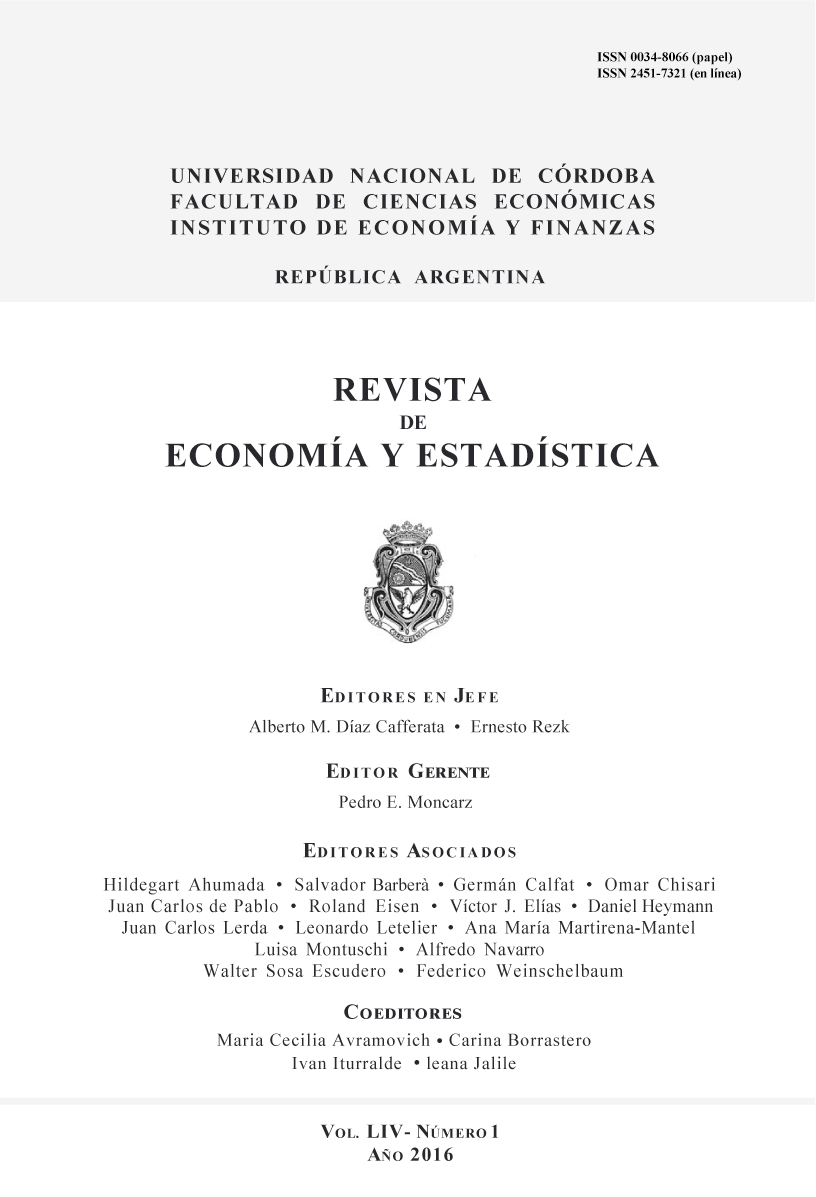La crisis europea y el mito de la recuperación irlandesa: una mirada
DOI:
https://doi.org/10.55444/2451.7321.2016.v54.n1.19431Palabras clave:
Eurozona, crisis bancaria, medidas de austeridad, tipos de interés, PIB, RNBResumen
En este artículo en primer lugar examino los puntos principales de la crisis de la eurozona (UME), mostrando que la credibilidad de un tipo de cambio fijo, junto con la libre circulación de capitales en la UME determinó un exceso de confianza, una caída excesiva de las tasas de interés y superabudancia en la demanda de prestamos, lo que hizo colapsar el sistema cuando se produjo la nombrada crisis la cual tuvo origen en el exterior de la zona. Esa crisis dañó las finanzas públicas, pues que el sistema bancario tuvo que ser rescatado por los gobiernos. En segundo lugar, analizo una aparente historia de éxito de la recuperación de la crisis que parece debida a la austeridad: la de Irlanda. Resalto que el gobierno irlandés saliente en 2010 actuó bien en el medio de la crisis financiera, a pesar de la eficacia y conveniencia de las medidas de austeridad. Pero también recojo hechos y cifras sobre lo que sólo aparentemente parece ser una verdadera recuperación y que sin embargo se obtuvo mediante algunos trucos de contabilidad inevitables y dependientes de una nueva normativa obligatoria de contabilidad nacional tomada a nivel de la UE y relativa al tratamiento de las inversiones. Desafortunadamente todo esto produjo y todavía produce cifras infladas para el PIB y el PNB, mientras que los estándares de vida de los ciudadanos irlandeses siguen siendo no muy afectados.
Descargas
Referencias
Atish G., Mahvash S. Q., Charambolos G. T. (2014). “Friedman Redux: External Adjustment and the Exchange Rate Flexibility”. No 14/146, IMF Working Papers, International Monetary Fund.
Bagnai A. (2012). Il tramonto dell’Euro. Ed. Imprimatur, November.
Barry F., FitzGerald J. (2001) “Irish Fiscal Policy in EMU and the Brussels-Dublin Controversy” in Fiscal Policy in EMU: Report of the Swedish Committee on Stabilization Policy in EMU, Stockholm. Statens Offentliga Utredningar.
Beker V. A. (2013). “The experience of three crises: the Argentine default, the American subprime meltdown, and the European debt mess”. Real-world Economics Review, issue no. 65.
Beker V. A. (2010).“ On the economic crisis and the crisis of economics”. Economics Discussion Papers 2010-18. Kiel Institute for the World Economy. Available at http://econstor.eu/bitstream/10419/36658/1/630979766.pdf
Bergin A., Fitzgerald J., Kearney I., O’Sullivan C. (2011). “The Irish Fiscal Crisis”, National Institute Economic Review, No. 217. pp. R47-R59.
Callan T., Keane C., Savage M., Walsh J. (2013).“Distributional Impact of Tax, Welfare and Public Pay Policies: Budget 2014 and Budgets 2009–2014.
Ci?kowicz P., Rzo?ca A., Trzeciakowski R. (2015). “Membership in the Euro Area and Fiscal Sustainability. Analysis Through Panel Fiscal Reaction Functions”. Working Papers Series 1501, Italian Association for the Study of Economic Asymmetries, Rome (Italy) . Available at http://www.asimmetrie.org/wp-content/uploads/2015/08/AISWP201501.pdf
Dunn M. (2015). “Annual national accounts - how ESA 2010 has changed the main GDP aggregates”, Eurostat - statistics explained. Available at http://ec.europa.eu/eurostat/statistics-explained/index.php/Annual_national_accounts_-_how_ESA_2010_has_changed_the_main_GDP_aggregates
Department of Environment, Heritage and Local Government of Ireland (2010). “Quarterly House Prices Bulletin”, November.
European Central Bank (2012). “Convergence Report May 2012”. Available at https://www.ecb.europa.eu/pub/pdf/conrep/cr201205en.pdf?af1f4ecc8ca30834e2c70bb04af692fa.
European Central Bank (2010). “Convergence Report”. Available at https://www.ecb.europa.eu/pub/pdf/conrep/cr201005en.pdf
European Central Bank (2003). “Policy Position of the Governing Council of the European Central Bank on Exchange Rate Issues Relating to the Acceding Countries”, December 18th.
European Commission (2014). “Convergence Report 2014”, June 4th.
European Commission (2012). “Convergence Report 2012”, May 30th.
European Commission (2012). “Specifications on the implementation of the Stability and Growth Pact, and Guidelines on the format and content of Stability and Convergence Programmes”, January 24th.
European Commission (2010). “Luxembourg Report prepared in accordance with Article 126(3) of the Treaty”, May 12th.
European Commission (2002). “Report from the Commission – Convergence Report 2002 Sweden”, May 22nd.
European Commission (1998).“European Economy n. 65 1998: Convergence Report 1998”, March.
European Monetary Institute (1995). “EMI Annual Report 1994”, April.
European Monetary Institute (1995).“Progress towards convergence”, November.
Feldstein M. (2005).“The Euro and the Stability Pact”, NBER, Working Paper 11249.
Fernandez-Villaverde J., Garicano L., Santos T. (2013). “Political Credit Cycles: The Case of the Eurozone”. NBER Working Papers 18899.
FitzGerald J. (2015) “John FitzGerald: Revised CSO figures are a dose of reality on deficit”. The Irishtimes. Available at http://www.irishtimes.com/business/economy/john-fitzgerald-revised-cso-figures-are-a-dose-of-reality-on-deficit-1.2327121, 2015.
FitzGerald J. (2014). “The Irish Recovery From the Crisis”, CESifo Forum , Vol. 15 , No. 2 , pp. 8-13.
FitzGerald J., E. Morgenroth E. (2006). “Ex Ante Evaluation of the Investment Priorities for the National Development Plan 2007-2013”, Research Series, Economic and Social Research Institute (ESRI), number PRS59.
Gianviti F., Krueger A., Pisani-Ferry J., Sapir A., Von Hagen, J. (2010). “A European Mechanism for Sovereign Debt Crisis Resolution: A Proposal. Bruegel. Available at: http://aei.pitt.edu/15123/1/101109_BP_Debt_resolution_BP_clean_01.pdf
Hennigan M. (2015). “Fact and Fiction: Time to review Ireland’s Economic Statistics?”. Finfacts. Available at http://www.finfacts.ie/irishfinancenews/article_1028946.shtml
IMF (2013). “Ireland: Ninth Review Under the Extended Arrangements”. Country Report No. 13/93. Available at: http://www.imf.org/external/pubs/ft/scr/2013/cr1393.pdf.
Irish Central Bank (2013). “Residential Mortgage Arrears and Repossesions Statistics” Information Release. Available at: https://www.centralbank.ie/statistics/data-and-analysis/credit-and-banking-statistics/mortgage-arrears/previous-statistical-releases.
Kelly M. (2009). “The Irish Credit Bubble”, Working paper series WP09/32 , Dublin: UCD Centre for Economic Research
Keynes J. M. (2015). The economic consequences of Mr. Churchill. London : L. and V. Woolf at the Hogarth Press.
Krugman P.R. (2009). The Return of Depression Economics and the Crisis of 2008. W. W. Norton, New York.
Maître B., Russell H., Whelan C. (2014). “Trends in Economic Stress and the Great Recession in Ireland An Analysis of the CSO Survey on Income and Living Conditions (SILC)”, Department of Social Protection of Ireland.
O’Connell P.J. (2012). “Cautious adjustment in a context of economic collapse: The public sector in the Irish crises”, in Vaughan-Whitehead, D. (ed.) The Public Sector Shock: The Impact Of Policy Retrenchment In Europe, Geneva: International Labour Office.
O’Leary J. (2010). “External Surveillance of Irish Fiscal Policy During the Boom”, Irish Economy Note No. 11. Available at: http://www.irisheconomy.ie/Notes/IrishEconomyNote11.pdf
Pérez-Caldentey E., Vernengo M. (2012). “The Euro Imbalances and Financial Deregulation: A Post-Keynesian Interpretation of the European Debt Crisis.” Levy Economics Institute of Bard College Working Paper No. 702. Available at http://www.levyinstitute.org/pubs/wp_702.pdf
Rajan R. (2005). “Has Financial Development Made the World Riskier?” NBER, Working Paper 11728.
Reinhart, C.M., Rogoff K. S. (2004). “Serial Default and the ?Paradox ? of Rich to Poor Capital Flows.” National Bureau of Economic Research. Working Paper 10296. Available at http://www.nber.org/papers/w10296
Reinhart, C. M., Rogoff. K. S. (2008a) “Banking Crises: An Equal Opportunity Menace”. National Bureau of Economic Research Working Paper 14587. Available at http://www.nber.org/papers/w14587
Reinhart, C. M., Rogoff K. S. (2008b). “This Time is Different: A Panoramic View of Eight Centuries of Financial Crises.” NBER Working Paper No. 13882. Available at http://www.nber.org/papers/w13882.pdf
Russell H., Watson D., McGinnity F. (2013). “Unemployment and subjective well-being”, in Gallie,D. (ed). Economic Crisis, Quality of Work and Social Integration: The European Experience, Oxford: Oxford University Press.
Russell H., Maître B., Donnelly N. (2011). “Financial Exclusion and Over-Indebtedness in Irish Households”, Dublin: Department of Community Equality and Gaeltacht Affairs and Economic and Social Research Institute.
Sapir J. (2012). “Le coût du fédéralisme dans la zone Euro”. Available at http://russeurope.hypotheses.org/453
Shiller R. J. (2000). Irrational Exuberance. Princeton University Press.
Tornell A., Velasco A. (2005). “Fixed versus Flexible Exchange Rates: Which Provides More Fiscal Discipline?” NBER, Working Paper 5108, Available at http://www.nber.org/papers/w5108.pdf
Watson D., Maître B. (2013). “Social Transfers and Poverty Alleviation in Ireland: an Analysis ofthe Survey of Income and Living Conditions 2004–2011”, Dublin: Economic and Social Research Institute and Department of Social Protection.
Descargas
Publicado
Número
Sección
Licencia
Derechos de autor 2016 Marco Biagetti

Esta obra está bajo una licencia internacional Creative Commons Atribución-NoComercial-SinDerivadas 4.0.
Aquellos autores/as que tengan publicaciones con esta revista, aceptan los términos siguientes:
Los autores/as conservarán sus derechos de autor y garantizarán a la revista el derecho de primera publicación de su obra, el cuál estará simultáneamente sujeto a la Licencia Creative Commons Atribución-NoComercial-SinDerivar 4.0 Internacional que permite a terceros compartir la obra siempre que se indique su autor y su primera publicación esta revista.
Los autores/as podrán adoptar otros acuerdos de licencia no exclusiva de distribución de la versión de la obra publicada (p. ej.: depositarla en un archivo telemático institucional o publicarla en un volumen monográfico) siempre que se indique la publicación inicial en esta revista.
Se permite y recomienda a los autores/as difundir su obra a través de Internet (p. ej.: en archivos telemáticos institucionales o en su página web) antes y durante el proceso de envío, lo cual puede producir intercambios interesantes y aumentar las citas de la obra publicada. (Véase El efecto del acceso abierto)














